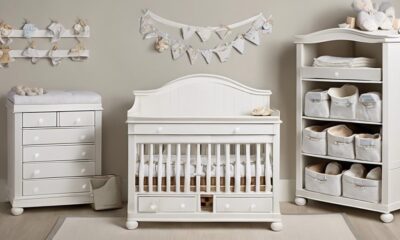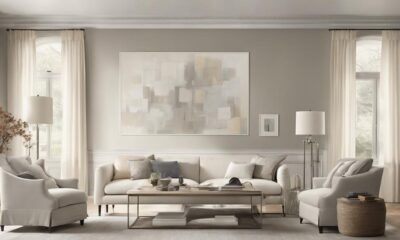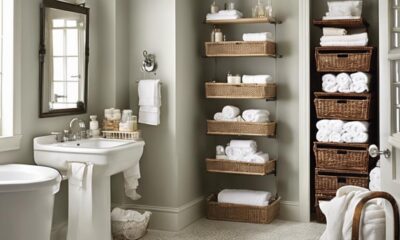Decor
How to Decor a Small Living Room
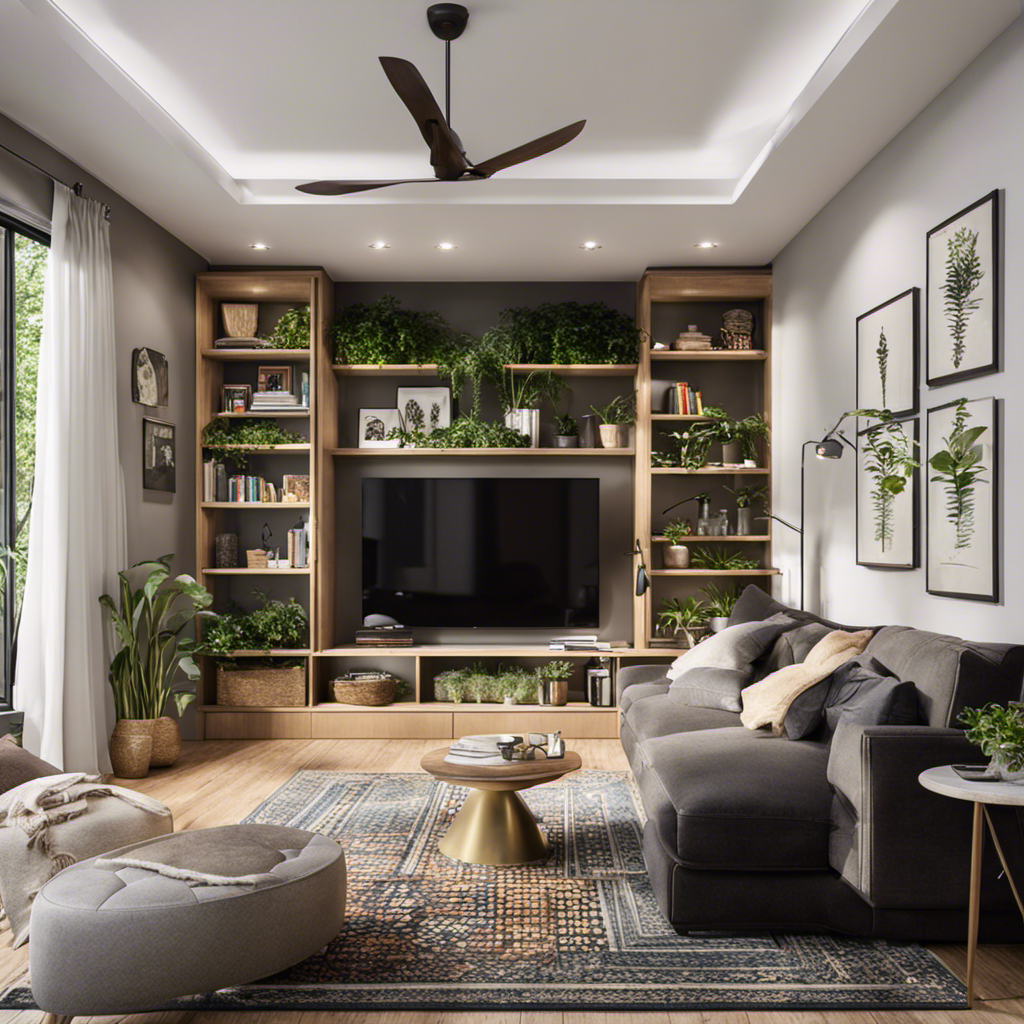
Looking to transform your small living room into a cozy oasis that feels double its size? You’ve come to the right place.
Get ready to unlock the secrets of space-saving furniture, clever storage solutions, and stunning wall decor ideas.
With our expert tips and tricks, you’ll be able to arrange your furniture like a pro and create a color scheme that will make your living room feel open and inviting.
Say goodbye to cramped spaces and hello to a stylish haven you’ll never want to leave.
Key Takeaways
- Utilize multifunctional furniture with built-in storage compartments
- Choose light and neutral colors to create a sense of openness
- Maximize natural and artificial lighting to make the room feel more spacious
- Incorporate mirrors strategically for visual expansion and added elegance
Space-Saving Furniture Ideas
If you’re looking to maximize your space, consider using space-saving furniture ideas in your small living room.
Space-saving design is all about making the most out of every inch available.
One great option is to invest in multifunctional furniture. For example, a sofa bed serves as both seating and a guest bed, perfect for small apartments or when hosting overnight visitors.
Another idea is to choose coffee tables or ottomans that have built-in storage compartments to keep your living room clutter-free.
Wall-mounted shelves can also be a great addition, providing extra storage without taking up floor space.
By incorporating these space-saving furniture ideas, you can create a functional and stylish living room, even in a small area.
Now, let’s move on to the next section, where we will explore color schemes for small living rooms.
Color Schemes for Small Living Rooms
To create a visually appealing space, you should consider using light and neutral color schemes in your small living area. Light colors, such as whites, creams, and pastels, create a sense of openness and brightness, making your room appear larger than it actually is.
Neutral tones, like grays and beiges, provide a calming and sophisticated backdrop for your furniture and decor.
When it comes to furniture placement, opt for smaller-scale pieces that fit well within the space. Avoid overcrowding the room with bulky or oversized furniture, as it can make the space feel cramped.
To add depth and interest, consider incorporating an accent wall in a contrasting color. This will draw the eye and create a focal point in the room.
Now, let’s explore lighting tips to maximize space without compromising on style.
Lighting Tips to Maximize Space
When it comes to maximizing space in your small living area, consider using strategic lighting techniques. The right lighting can make a significant difference in how spacious your room feels.
Start by considering the natural vs. artificial lighting options for small spaces. Natural light is ideal as it creates an open and airy atmosphere. Utilize windows and skylights to let in as much natural light as possible. However, if natural light is limited, artificial lighting can still work wonders.
Use a combination of overhead lights, floor lamps, and table lamps to evenly distribute lighting throughout the room. Additionally, accent lighting techniques can create the illusion of a larger space. Use wall sconces to highlight architectural features or artwork and create depth.
By strategically incorporating lighting into your small living room, you can make it feel more spacious and inviting.
Now, let’s move on to wall decor ideas for a small living room.
Wall Decor Ideas for a Small Living Room
Consider incorporating mirrors into your space for an easy and effective way to visually expand your living area. Mirrors have long been used as a design tool to create the illusion of a larger space. Hang a large mirror on a focal wall to reflect light and make the room feel more spacious.
You can also use smaller mirrors strategically placed throughout the room to enhance the mirror illusion. Not only do mirrors add depth to your living room, but they can also serve as a stylish art display. Choose mirrors with interesting frames or shapes to add a touch of elegance to your space.
Now that you have maximized your wall decor, let’s explore some creative storage solutions for your small living room.
Creative Storage Solutions
Now that you’ve maximized your wall decor, let’s take a look at some creative storage solutions for your compact living area.
In a small space, it’s crucial to make the most of every inch. Embrace unique organizing hacks and hidden storage options to keep your living room tidy and clutter-free.
One clever solution is to use multifunctional furniture pieces. A coffee table with built-in storage compartments can hold your books, magazines, and remote controls, while also providing a surface for drinks and snacks. Additionally, ottomans with hidden storage inside are perfect for stashing blankets, pillows, or even extra seating.
Another smart idea is to utilize vertical space. Install floating shelves on your walls to display decorative items while also serving as storage for small items like candles, photo frames, or plants. You can also hang a pegboard or a wall-mounted organizer to keep your keys, bags, and other essentials within reach.
By incorporating these unique organizing hacks and hidden storage options, you can maximize the functionality of your small living room without sacrificing style.
Now, let’s explore the next section on arranging furniture in a small living room seamlessly.
Arranging Furniture in a Small Living Room
To maximize your space, try arranging furniture in a small living room by placing the sofa against the longest wall. This simple trick instantly creates more floor space and makes the room feel larger.
Here are a few more tips to help you make the most of your limited square footage:
-
Use multi-functional furniture: Opt for pieces that serve multiple purposes, like a coffee table with hidden storage or a sofa that can be converted into a bed.
-
Utilize vertical space: Install shelves or floating wall units to take advantage of the vertical space in your room. This not only provides additional storage but also draws the eye upward, creating an illusion of height.
-
Create zones: Divide your living room into different zones, such as a seating area, a workspace, and a dining area. This helps to visually separate the space and makes it feel more organized.
Frequently Asked Questions
How Can I Incorporate Plants Into a Small Living Room Without Taking up Too Much Space?
To incorporate greenery in your small living room without sacrificing space, maximize vertical space. Hang plants from ceiling hooks, use wall-mounted planters, or place them on floating shelves. This adds a touch of nature while keeping your floor space free.
Are There Any Specific Tips for Choosing Rugs That Will Make a Small Living Room Appear Larger?
To make a small living room appear larger, choose rugs wisely. Opt for lighter colors and patterns that create an illusion of space. Avoid oversized rugs that overwhelm the room. These tips will maximize your space.
What Are Some Creative Ways to Add Personal Touches and Accents to a Small Living Room?
To add personal touches to your small living room, consider incorporating plants that don’t take up much space. Get creative with unique accents like colorful throw pillows, wall art, and decorative shelves to make the space truly yours.
How Can I Effectively Divide a Small Living Room Into Different Functional Areas?
To effectively divide a small living room into different functional areas, try using dividing techniques like room dividers or curtains. Additionally, utilize space-saving furniture such as multifunctional pieces or furniture with built-in storage.
Are There Any Specific Recommendations for Choosing Curtains or Window Treatments That Will Enhance the Space in a Small Living Room?
When choosing curtains or window treatments for a small living room, consider color coordination to enhance the space. Opt for lightweight fabrics like sheer curtains or blinds to create a sense of openness and let natural light in.
Conclusion
Congratulations on completing the journey of transforming your small living room into a cozy haven! By implementing space-saving furniture ideas and clever storage solutions, you have maximized every inch of your space.
The carefully chosen color schemes and lighting tips have added depth and ambiance to the room.
With the perfect wall decor and furniture arrangement, you have created a space that not only looks stunning but also feels spacious and inviting.
Remember, no matter the size, your living room can always be a reflection of your personal style and a place where memories are made.
- About the Author
- Latest Posts
Meet Katherine, the creative enthusiast at ByRetreat who infuses her boundless passion for design into every remote workspace she crafts. With an innate sense of creativity and an eye for unconventional beauty, Katherine brings a unique and inspiring perspective to the team.
Katherine’s love for design is infectious, and her ability to think outside the box sets her apart. She believes that true artistry lies in embracing a variety of styles and mixing them harmoniously to create captivating spaces. By combining different textures, colors, and patterns, Katherine weaves a tapestry of creativity that breathes life into each remote workspace.
Decor
The Best Textiles For Decorating Your Home: A Comprehensive Guide

When it comes to choosing textiles for home decor, there is no universal solution. That’s why our detailed guide covers various fabric options, their advantages and disadvantages, and how to select the right one for your specific needs. Whether you’re looking for curtains, bed sheets, throws, or tapestries, this guide will help you make informed decisions about selecting fabrics for your interior design.
Types of fabrics to use for decorating
Textile decorating can be a fun and rewarding activity for anyone, regardless of experience or skill level. As a first-time textile decorator, it’s important to be aware of the many types of fabrics that are available and their various uses. For example, colored fabrics can add a pop of color to any room in your house, while neutrals can work well with nearly any décor style. To get started, consult a guide like this one which covers different types of fabrics and their uses in detail. With a little bit of research and some good old fashioned textile decorating, you’ll be on your way to creating a beautiful home that you’ll love!
Chenille
Chenille is a versatile fabric that can be used for a variety of purposes. Chenille has everything from adding a touch of luxury to your home to creating sophisticated decorations. It is also an affordable fabric that you can use in many ways – from furnishing smaller spaces to making larger pieces look more refined and elegant. In addition, chenille is very easy to care for – just wash it like any other textile and it will come back looking new again! So don’t wait – begin using this luxurious textile today!
Batiste
Batiste is a lightweight and delicately scented fabric that can be used for everything from curtains to tableclothes. It is perfect for adding a touch of luxury to any space, making it the ideal choice for draperies and bed linen. Washing batiste before use will help to avoid any unpleasant smells or wrinkles in the future. Make sure to shop with caution as this textile is often sold at a higher price than other fabrics of its kind!
Silk Georgette
If you’re looking for a luxurious fabric that can be used to decorate your home in many different ways, silk georgette is the perfect option. Its rich color and drapey properties make it perfect for curtains, bedding, and anything else you might want to spruce up. Whether you’re looking for a modern or traditional look, silk georgette is sure to impress.
The best ways to choose the right fabric for the given task
When it comes to decorating your home, there are so many fabrics available to choose from. But which one is the best for the task at hand? To help you make a more informed decision, we’ve put together a comprehensive guide on the best ways to choose the right textile for the given task. So, whether you’re looking for curtains, bedding, or upholstery, these tips will help you find the right fabric for the job. First and foremost, think about the intended use of the textile. For example, is it for curtains? Bedding? Upholstery? Once you’ve determined the use, compare different fabrics and find the one that is best suited for your needs. For example, if you’re looking for a light and airy fabric for curtains, try a linen fabric instead of a heavyweight cotton one. Lastly, follow these simple tips when choosing textile for your next decorating project:
Choosing Fabric for Curtains and Drapes
When choosing the perfect fabric for curtains and drapes, it is important to keep a few things in mind. For starters, think about the function of the fabric – will it be used primarily for blocking out light or letting in light? Secondly, consider what type of window or door you are working with. Do you want your drapes to be sheer so that natural light can come through them, or do you want them to be heavier so they block out more brightness? There are a variety of textures and designs available on fabrics these days; choose something that appeals to you. Additionally, always test a fabric before buying it – by folding it up and trying it on the door or windowill. This way, you can avoid any unpleasant surprises down the line!
Choosing Fabric for upholstery
There are a variety of fabrics available on the market for upholstery, each with its own unique features and benefits. Before making a purchase, it is important to determine the fabric’s purpose – whether it is for furniture, drapery or another textile article. The four main categories of fabrics used in upholstery are natural fibre (such as cotton), synthetic fibres (including ramie and polyester) blended materials (made from 50% natural and 50% synthetic fibres), artificial fibre blends (usually made from 60-70% man-made fibres) and finally pure artificial fibres. When purchasing fabric forupholstery, it is also important to consider weight and texture. Heavier woven fabrics will give more drape than lightweight ones; choose one that falls within your design concept. For areas where you want less bulk or coverage such as chair arms or window panes, use sheer or light textured fabrics with intricate designs or textures.
Choosing Fabric For Table Cloths and Napkins
When choosing the right fabric for tablecloths and napkins, it is important to consider the occasion. For example, choose a delicate fabric like silk or lace if you are hosting a formal dinner. On the other hand, if you are having simple drinks at home with friends, go for something sturdy like cotton. Mixing and matching different fabrics will give you endless possibilities when it comes to creating the perfect look. So go ahead! And don’t be afraid of experimenting – that’s what makes textile designing so fun!
Tips to Choose the Right Fabrics When Buying Linens
When it comes to choosing the right fabrics for your home, there are a few things you need to keep in mind. For starters, consider the season. Certain fabrics work better during certain times of the year – think cotton prints for spring and summertime and florals for fall and winter. Next, take into account how often you plan on using the fabric. Heavy materials should be used for furniture that will see a lot of use (like a sofa), while delicate materials like lace can be used on accessories or areas that get less wear (like curtains). And last but not least, remember to factor in how much weight each fabric has! The scale will help you determine which type of fabric is most appropriate for your intended project or item.
How to choose the right color palette for your fabric choice
When decorating your home, it’s important to consider a few key factors, namely the décor and style of your home. Once you have a general idea of what you want, it’s time to start selecting fabrics. Follow these tips to choose the right color palette for your needs: select complementary colors, use muted shades and mix patterns together. Once you have a few favorites, take them up a notch by using accessories like curtains or rugs in the same print as your chosen pieces! Your new textile collection is guaranteed to brighten up any space in your home!
Decide the purpose of your fabric
When choosing a fabric for your home, it is essential first to determine the purpose it will serve. Is it for decoration only? For insulation? Or maybe you want an eclectic and stylish look that incorporates different fabrics. Once you have decided on the purpose of your chosen material, consider colors that work well with your furnishings and style. Be brave when mixing and matching fabrics as this will add depth and variety to your room’s appearance. Finally, be sure to choose a fabric wisely to avoid any headaches down the line – bad breath or mildew can happen very quickly in warm weather!
Determine your style
In order to create a cohesive and stylish interior, it is important to start by considering your style and the room’s décor. Once you have a good idea of what you are looking for, then look for colors that will work well together. Stick to neutrals or earth tones so your fabric can easily blends in with any other elements in the room without clashing. Bright colors might be too overpowering when used together with other parts of an interior design scheme.
Look for coordinating colors
When it comes to choosing colors for your home, it is essential to consider colors that are in the same family. This will make the process a lot easier and you’ll be able to achieve a more cohesive look overall. Avoid using too many different shades or colors as this can lead to clashes and create a messy look. Take into account what color schemes work well with other pieces of furniture in your home and use those as guidelines when selecting new colors. Mixing different tones together can also create an interesting effect – so experiment!
Choose a fabric with a high thread count
Choosing the right fabric for your home is important. Not only does it need to be of the best quality, but it should also have a high thread count so that seams won’t show through and it will be less likely to wrinkle or fade in the future. This means picking fabrics with a higher thread count, such as linen or silk. Consider your color palette as well – go for colors that coordinate well with another decor in your home and personal taste preferences. You’ll never regret choosing a high-quality fabric!
Tips on how to care for your fabrics
No room is complete without beautiful textiles. Whether it’s curtains, bedding, or even just a throw, textile decorating has become a popular trend. With so many options available, it can be hard to know which ones to choose. That’s where this comprehensive guide comes in! In it, we’ll discuss tips on how to care for your fabrics and offer recommendations for different types of textile decor. We hope that by following these tips, you’ll be able to enjoy beautiful textiles in your home for years to come!
How to choose the right fabric
Choosing the right fabric for a project can be tricky, but it’s important to take into account a few key factors. For example, think about the type of fabric (for example, cotton vs linen), its texture (smooth or textured), and its pattern. Once you have decided on one or two fabrics, it’s time to test them out before making your purchase. It is also important to pay attention to sewing techniques – zigzag stitch in particular is recommended for delicate fabrics like silk and lace. And don’t be afraid to experiment with different fabrics – mix and match them until you find something that appeals to you!
Tips on laundering and drying your fabrics
Keeping your fabrics looking their best is essential for an elegant look in any room. Follow these easy tips and you’ll be on your way to achieving this goal: Don’t overload the machine with fabric – one cycle usually does the trick. Hang them to dry, which will help keep their shape and color intact. Use cold water when laundering and hot water when drying. When cleaning, use mild soap and a soft brush – avoid harsh chemicals or bleach. Air your fabrics regularly – put them in the sun or in a warm place if you can! Follow the care instructions on each fabric label – these will usually include information about how often to wash, dry, or iron them
How to add interest and life to your fabrics
Adding interest and life to your fabrics is easy if you know how to do it. By choosing fabrics that are in season or have a design you admire, storing them properly, and washing them correctly, you can get the look you desire without any hassle. Additionally, dyeing your fabric can add a new dimension of personality to it. So whatever style or mood you’re looking for – textile inspiration will be right at hand!
Your Weekend Retreat at Home
Decorating your home can be a great way to relax and de-stress. Whether it’s a weekend getaway or just a change of scenery, choosing the right textile for the job is essential. In this comprehensive guide, we will teach you about different fabrics that can be used for decorating your home, and provide you with a plethora of ideas and inspiration. So, pack your bags this weekend and head to your nearest textile store!
Think about your style
When designing your home, you should think about what makes you happy. Consider the colors and patterns that appeal to you, as well as the type of style that matches your personality and taste. Once you have a basic idea, start shopping for fabrics and accessories! This way, everything will be in place when furnishing your new home.
Discover the best fabrics for your decor
Choosing the right fabrics for your decor can be a daunting task, but with a little research it’s easy to find the perfect options. Start by thinking about your style and what type of mood you want to create. Do you want something light and airy or would you prefer something more substantial? Once you’ve decided on a style, it’s time to start looking at different fabrics. There are so many beautiful materials available these days that it can be hard to decide which one is best suited for your needs. Our guide will help make the selection process smoother by specifying important factors such as quality, durability, and how they will look in relation to other elements of your home décor. So don’t wait any longer – take our advice and pick the perfect fabric for your unique space!
Tips for choosing the right fabric
When it comes to choosing the right fabric for your personal weekend getaways, you need to keep a few things in mind. First and foremost, take into account the theme of your home. Are you more inclined toward earthy tones or bright patterns? By playing around with neutrals and earthtones, you can give your space a natural look that will be harmonious with all of its surroundings. If you want some color in your retreats but don’t want it to overpower everything else, choose warm colors like browns and oranges. But again – be sure to check out the fabric beforehand so that it’s sturdy enough to withstand wear and tear over time!
How to sew with fabric
Sewing with fabric can add a touch of sophistication and life to your decor. There are a variety of fabrics available in the market, so it’s important to find one that is perfect for your taste. Choose the right sewing machine for the job – not too heavy and not too light. Sewing with fabric isn’t difficult but does require some basic skills, so be sure to follow these steps: 1) Start by choosing the right sewing machine – not too heavy and not too light. 2) Figure out where you would like the seam allowance to start and end – this will determine how wide or narrow the finished seam will be. 3) Mark your Fabric along both edges of what you want it sewn onto – Try pinning it first just in case you make any mistakes later on! 4) Make tiny 1/4 inch marks at intervals with a tailor’s chalk (or another type of marking utensil). These marks will show where each stitch should go to create a straight seam.
Conclusion
Decorating your home can be a fun and rewarding experience. Luckily, textile options are wide and varied, making it easy to find suitable material for your needs. In this comprehensive guide, different textiles will be analyzed and discussed in-depth. This includes topics like their unique features and benefits, how to choose them, and how to care for them. So, whether you’re looking for curtains, bed sheets, or table linens, this guide has you covered!
Frequently Asked Questions
Which types of fabrics are best suited for interior decoration?
When it comes to choosing the best fabrics for interior decoration, you have two main options: natural and synthetic. Natural fabrics like cotton and linen are natural materials that are often more versatile and can be heavier. However, they also tend to be more versatile in terms of color and style. Synthetic materials like polyester are often less expensive than natural materials, but they can fade in the sun or contain harmful chemicals. It’s important to choose a fabric that will compliment your room’s color scheme and style. Additionally, you’ll want to choose a fabric that you’ll feel comfortable living with. Once you’ve chosen a fabric, make sure to measure the area you’ll be covering and buy the correct size of fabric.
How do I choose the right color palette for my home décor?
Choosing the right color palette for your home décor is a complex process that takes into account many different factors. For starters, think about your personality and lifestyle. What kind of colors do you prefer? Do you want to stay within a certain color range, or are you more experimental? Are you after a calm and relaxing atmosphere, or do you want something lively and exciting? Once you’ve figured out your preferences, it’s time to start thinking about tones. You can use one color throughout the entire house, or vary its tone by adding different shades. Additionally, it’s important to consider the mood you want your space to evoke. Do you want it to be peaceful and calming, or do you want it to be more lively and vibrant? Once you’ve got an idea of what you want, start narrowing down your choices to a final palette!
What are some of the best textile materials for decorating your home?
When you’re looking to decorate your home with textile materials, it’s important to consider the season, occasion, or theme of your house. Some great options include: Cotton sheets and bedspreads: cotton is a natural textile material that is machine-washable and wrinkle-resistant. It is perfect for summertime when you need a lightweight blanket that can be easily taken down. Broadcloth curtains: these curtains are made of broadcloth fabric, which is a type of soft cotton cloth with a high grade of weave. They are popular because they are elegant, versatile, and affordable. Rugs and floor mats from natural fibers like wool and silk: rugs and floor mats made of natural fibers are a great option for those who want to add personality and comfort to their homes. They eco-friendly, durable, and easy to care for. Textile art prints: textile art prints are a great way to add personality and eclectic style to any room in your home. They come in a variety of sizes and styles, and they can be hung on the wall or used as wall hangings.
Is it necessary to hire a professional to help me select the perfect fabrics and decorations for my home?
There is no need to hire a professional to help you select fabrics and decorations for your home – in fact, there are plenty of great resources online. You can browse through different websites like The Huffington Post, Houzz, or Apartment Therapy for ideas. Additionally, you can watch Youtube videos or take costumer’s advice from friends and family. When selecting fabrics and decorations for your home, keep in mind the following tips: – Consider your budget: Stick to neutrals if you’re on a tight budget; choose pieces that will look good together; avoid prints unless they’re subtle; and go for natural materials whenever possible. – Choose pieces that will coordinate well together: Make sure to choose fabrics and decorations that will work well together in your space. – Avoid prints unless they’re subtle: Prints can be a bit too loud and busy for some people’s homes. Consider opting for a subtle print instead.
What are some of the best materials to use for curtains, bedding, and other home decorations?
When it comes to choosing textiles for your home decor, consider natural materials like cotton, wool, or silk. These materials are gentle on the skin and easy to care for. Alternatively, you can go for synthetic materials that are both stylish and durable – like polyester or rayon. If you’re looking for something a little more special and unique, try using jacquard fabrics! These are textile fabrics with a variety of patterns and designs that are usually not found in conventional textile fabrics.
What are some of the best textile materials for decorating your home?
When it comes to beautiful textile materials for decorating your home, silk fabrics, cashmere woolen fabrics, cotton muslin fabric, rayon jersey fabric, and other soft materials like these are some of the best options. These materials have different textures, colors, and patterns that can be used to create an elegant and luxurious atmosphere in your home. They’re also easy to care for and require less maintenance than other types of textiles. So if you’re looking to spruce up your home décor with a touch of luxury, then consider using these textile materials.
How do I choose the right color palette for my home décor?
When it comes to choosing the right color palette for your home décor, start by thinking about the mood you want to create. Once you have a general idea of the feeling you’re going for, start narrowing it down to specific colors. Often times, neutrals can be great base colors for any decorating scheme. Think about textures and materials when selecting textile pieces- velvet fabric may look luxurious but is also very expensive, while cotton will be cheaper but not as soft or durable.
Which types of fabrics should I avoid if I want my decor accents to look consistent throughout my house?
When it comes to textiles for your home, you should avoid fabrics with a lot of dyes and harsh chemicals. This is because these ingredients can quickly lose their color and become less pleasant to the touch. Instead, consider using natural fibers like cotton and linen. Not only are they eco-friendly and healthier for your skin, but they also tend to last longer and look nicer than synthetic fabrics. When it comes to prints, avoid prints that are too busy or loud. Stick to solids or subtly patterned pieces instead. And finally, consider using accent pillows, curtains, throws and other accessories in complementary colors to bring the whole room together.
How can I choose the right textile for the job at hand?
When it comes to choosing the right textile for a job at hand, think about what feel you’re going for. Some common textures are suede, jersey, and chiffon. Next, consider the material itself and its properties. Some common types of fabrics are wrinkle-resistant, resistant to fading in sunlight or heat, etc. Once you have decided on these basics, it’s time to get creative! Start by thinking about the design you want. Are you looking for a solid color scheme, or would you like multiple colors incorporated? Then decide on how detailed you want your design to be – do you want it to be very simple or elaborate? Finally, make sure to measure yourself before making any purchases so that the textile will fit properly.
What are some common mistakes that people make when choosing textiles for their home?
Some common textile mistakes that people make when choosing textiles for their home are purchasing toxic or harmful textiles, not taking into account the environment, and not considering cultural context. Many people choose to buy textiles that are toxic and harmful to the environment. By doing so, they are contributing to the problem of textile waste and pollution. Furthermore, these items may not be comfortable or stylish to wear in a home. Another common textile mistake is not taking into account the cultural context of a place when choosing fabrics from another country. For example, many people choose to buy silk fabrics from Japan, China, or Thailand without knowing about their history or culture. This may not be wise because these countries have a long history of textile production and use different types of fabrics that can give your home a certain look or feel.
Which textures work well together when decorating with textiles?
When decorating with textiles, it’s always a good idea to go for textures that work well together. Textures can include things like cotton, woolen fabrics and silks, prints in different colors and patterns, and brightly colored accessories. By using textures in this way, you’ll add depth and interest to your home décor while keeping it calming and stylish.
What is the best way to take care of textiles – by using a fabric protector or steaming them regularly?
If you are using textiles in your home, it is important to always use a fabric protector. Fabric protectors help to keep the fabrics from fading and getting damaged by spills and other accidents. You can also steam them regularly for extra protection.
Conclusion
As you can see in this comprehensive guide, there are a variety of fabrics that can be used for decorating your home. Whether you’re looking for a traditional look or something more modern, we’ve got you covered. In addition, we’ve outlined the best ways to choose the right fabric for the given task. So, whether you’re looking to add a touch of luxury to your home or want to spruce up your décor in a snap, we’ve got you covered! Make sure to check out our website for more helpful tips on home decorating.
- About the Author
- Latest Posts
Introducing Ron, the home decor aficionado at ByRetreat, whose passion for creating beautiful and inviting spaces is at the heart of his work. With his deep knowledge of home decor and his innate sense of style, Ron brings a wealth of expertise and a keen eye for detail to the ByRetreat team.
Ron’s love for home decor goes beyond aesthetics; he understands that our surroundings play a significant role in our overall well-being and productivity. With this in mind, Ron is dedicated to transforming remote workspaces into havens of comfort, functionality, and beauty.
Decor
How Often Should You Decorate Your Home?


The frequency with which you should redecorate your home depends on your individual pace of change. Your personal pace of change will determine how frequently you should update your home. It may be necessary to refresh it every three to five years or even more often, depending on the season and your mood. You can also switch up the furniture and accessories to give your home a new look. Whether you decide to update your decor annually or completely transform your entire house, set a personal goal to change your home as often as you desire.
Redecorating
You can’t go wrong by giving your home a fresh coat of paint. You should also know that redecorating your home is a process that follows your own evolution. That said, here are a few tips to keep in mind when redecorating your home.
You can add value to your home by redecorating. Over time, your home will start to look old and worn out. Exposure and time will wear down paint and carpeting, and even light fixtures. While redecorating isn’t always necessary, it can help you feel better about the appearance of your home and your personal taste.
When redecorating your home, it is important to consider your budget and your needs. Whether or not you plan on selling your home in the future will determine how often you redecorate your home. A lot of people choose to redecorate their home every three months, but it can depend on how often you want to change the look of your home. You can find inspiration on social media and get ideas from interior designers.
When redecorating your home, remember to keep up with style trends. The average American homeowner redecorates his or her home every five years. While it is hard work, redecorating your house can be very rewarding. At Decorist, we have countless clients who have used our tips to redecorate their homes.
Planning your decorating journey
One way to keep decorating costs low is to repurpose furniture. You can give an old piece of furniture a new look by reupholstering it or repainting it. You can also layer in accessories to make the new look complete. If you’re unsure where to start shopping, take pictures of the look you want to create.
- About the Author
- Latest Posts
Introducing Charles, the Editor in Chief at ByRetreat, whose passion for interior design and editorial excellence elevates every remote workspace to new heights. With his keen eye for detail, impeccable taste, and expertise in design, Charles brings a wealth of knowledge and creativity to the ByRetreat team.
As the Editor in Chief of a renowned lifestyle blog, Charles has honed his skills in curating captivating content and staying up-to-date with the latest trends in interior design. His deep understanding of aesthetics and the power of storytelling through design enables him to create remote workspaces that are not only visually stunning but also rich in personality and meaning.
Decor
How Much Do Home Decor Influencers Make Reviewing Products?
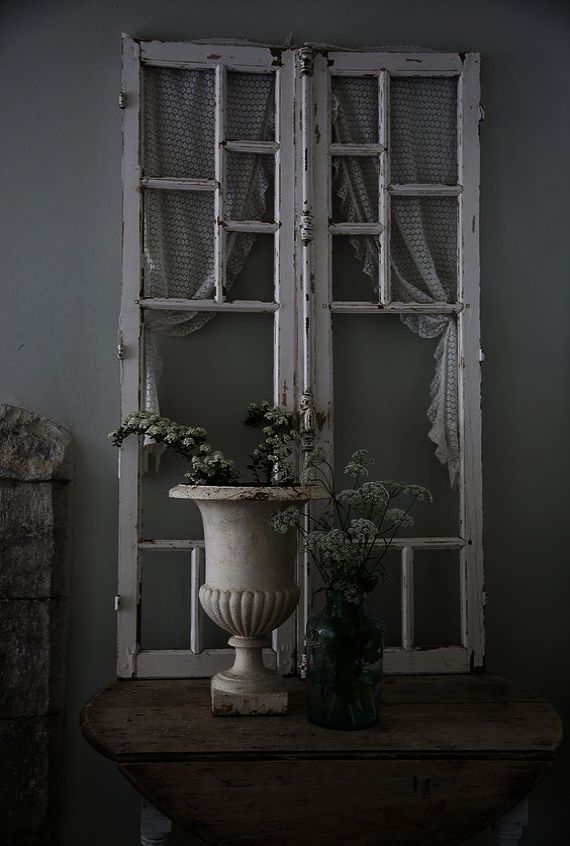

Home decor influencers have the potential to earn between $30,000 to $100,000 per year based on the size of their following. Their main sources of income often come from sponsored posts and product reviews. HGTV personality Joanna Gaines is recognized as the ninth top home decor influencer. Additionally, influencers frequently sell their own products to their followers and earn a portion of the sales as commission.
An average following of an influencer can earn between $30,000- $100,000 per year
A new study shows that home decor influencers who have a large following can make between $30,000 and $100,000 per year. This is a great income for someone with a passion for decorating and design. How can one get started? There are many ways to influence others and make money from your passion.
Promoting a product or service is one of the easiest ways to make money through influencer marketing. If you have a social media presence, consider asking influencers to endorse your products. While they may have huge followings, these numbers don’t always reflect the quality of their followers. If they don’t agree with your brand, they won’t be able to effectively promote it.
You can monetize your blog through paid promotions. If you have a large following and a niche, brands may reach out to you. Make sure you have a clear idea for your content and a package for working together. Afterwards, brands will promote your blog on their social media accounts and email your followers about their products. This can result in a large number of blog followers. Moreover, working with big brands will help you get more exposure, as they have huge budgets and more money to spend on marketing.
Influencer marketing is a rapidly expanding industry. By 2020, the US will spend $3 billion on influencer advertising. It is expected to grow even more with the increasing popularity of social media. In 2016, 36% companies paid influencers to provide product samples.
Creating a product and launching it is not an easy task. More than 70% of new product launches fail within the first one year. To develop and launch a high-quality product, you will need a team.
Influencers review products
Influencer marketing allows brands to reach potential customers by using trusted sources for recommendations. Influencers are trusted by 33% of consumers, while only 17% trust their friends or family to make a good shopping decision. Brands can increase sales and exposure by paying influencers to review products. They are trusted by their followers, which increases brand awareness and credibility. The question is often asked: How much do home decor bloggers make reviewing products?
While most influencers may not be well-known, they do have loyal fans. One example of such an influencer is Amanda Frederickson, a food blogger with over 100,000 followers. Although she isn’t a celebrity, she has a loyal following that has likely driven sales for several brands.
You can reach influencers by using social media and contact forms on their websites. Remember that people are always available to answer your emails. It’s important to ensure that you follow up on your requests twice. Be polite and do not bombard them. Try to make your message as unique and relevant as possible.
Influencers can earn millions of dollars per year. Sponsored videos are often charged by YouTube stars at prices ranging from $20,000 to $6000. Others earn thousands of dollars per month from advertising. Influencers can be a valuable asset to brands, regardless of whether it’s a paid partnership and a one-off campaign.
Once your campaign is running, you can begin negotiating influencer rates. You can calculate your influencers’ Influence Score using a site such as Dealspotr Marketplace before you negotiate a fee. This eliminates false followers and overinflated influencer rates.
Influencers earn money through sponsored posts
In order to make money on social media, home decor influencers can choose from various income options. It all depends on what niche they are in and the opportunities that they have. Some options require a greater commitment than others. Affiliate marketing, for example, may involve embedding coupon codes or special links into posts and then receiving a small commission when viewers click on the links. One of the most popular affiliate marketing programs is Amazon Associates. The company also has a specialized influencer program.
Sponsored posts may be one-off or ongoing. The length of the content and the audience the influencer is targeting will determine the amount of payment. If an influencer has 100,000 followers, and posts about one brand, they might charge $50 to $500 per post. It doesn’t matter what payment method you use, it is important that you understand the demographics and how the content will be used.
Besides sponsored posts, influencers also have the option of selling digital products. They can sell e-books or online tutorials to their followers. These sales can increase over time. This is a great way to make money with social media influencers. The potential for affiliate marketing is huge, and it is a great way to start making money on the internet.
A successful influencer can reach millions of followers. These influencers are well-known for their unique style and many followers on social media. They also make trustworthy recommendations about emerging trends. They often review new products that are hot in the market. Sometimes, they are even provided with products to review by the manufacturers.
The rate of payment for sponsored post depends on the influencer’s followers and how successful they have been in promoting their products. A typical influencer earns between $30 and $100k per sponsored post. A sponsored post can be as high as $250,000 for those with over one million followers.
Collaboration with brands is another way to make money from sponsored posts. This is similar to affiliate marketing, but it involves collaboration with brands. Instead of paying affiliate marketers, influencers are paid by the brand for each sponsored post. They are also paid in flat fees for the content created. These posts are often focused on a specific product placement, but they can also be about the company itself or even a special event.
:How Do Home Decor Influencers and Bloggers Monetize Product Reviews?
Home decor influencers and bloggers monetize product reviews by leveraging their audience and expertise to recommend products and earn from affiliate commissions, sponsored content, and collaborations. Understanding the best strategies for home decor blogger earnings insight is essential for maximizing monetization opportunities in this niche.
HGTV star Joanna Gaines is the ninth most influential home decor influencer
According to the HGTV Influencer index, Joanna Gaines is one of the top 10 home decor influencers. Her popular television show, Fixer Upper, has become an HGTV hit, garnering 24 million viewers during its two-season run. It grew by 72% from its first season, and the second-season episode was the highest-rated HGTV episode in 5 years.
Joanna Gaines is a TV host for home improvement and a businesswoman. She co-founded the Magnolia design firm and co-hosts the HGTV show Fixer Upper. While in college, she studied communications and worked as an intern in New York, where she fell in love with design. Her savvy design skills eventually led her to start flipping houses with her husband Chip.
Joanna Gaines, an influential home decor influencer, has a lot of DIY experience and a large social media following. Many of her projects are made with Home Depot products. As a home improvement company, Home Depot would likely benefit from partnering with the HGTV star. The company does not appear to be in financial trouble, but it will need to make a significant investment in the influencer market.
Joanna Gaines’ minimalist farmhouse style has become one of the most popular home decor trends in recent years. But her eclectic mix of styles is not limited to the classic farmhouse look. Joanna Gaines incorporates modern farmhouse design trends with classic designs and materials, making her collections feel up-to-date and on-trend. Some of her designs can be used throughout the space, while others can be used as accent pieces or feature walls. The popularity of the farmhouse look has increased in recent years thanks to TV shows such as HGTV’s Fixer upper, which has fueled a new interest in this style.
Joanna Gaines, a major player in the home decor and design world, has more than 11 million Instagram followers. She and her husband Chip Gaines have become an important part of the design conversation since the show was first aired in 2013. Their DIY Network was rebranded as Magnolia Network by the couple. It will debut in early next year.
- About the Author
- Latest Posts
Introducing Charles, the Editor in Chief at ByRetreat, whose passion for interior design and editorial excellence elevates every remote workspace to new heights. With his keen eye for detail, impeccable taste, and expertise in design, Charles brings a wealth of knowledge and creativity to the ByRetreat team.
As the Editor in Chief of a renowned lifestyle blog, Charles has honed his skills in curating captivating content and staying up-to-date with the latest trends in interior design. His deep understanding of aesthetics and the power of storytelling through design enables him to create remote workspaces that are not only visually stunning but also rich in personality and meaning.
-

 Vetted7 days ago
Vetted7 days ago15 Best Boxwood Varieties for Thriving in Full Sunlight
-

 Vetted1 week ago
Vetted1 week ago15 Best Ways to Label Clothes for Nursing Home Residents – Stay Organized and Efficient
-

 Decor2 days ago
Decor2 days agoAre Home Decor Stores Profitable?
-

 Vetted1 week ago
Vetted1 week ago15 Best Dryer Vent Hoses to Keep Your Laundry Room Safe and Efficient
-

 Vetted7 days ago
Vetted7 days ago14 Best Cleaners for Aluminum Surfaces – Shine Bright Like a Diamond
-

 Vetted1 week ago
Vetted1 week ago15 Best Spider Sprays to Keep Your Home Arachnid-Free
-

 Vetted1 week ago
Vetted1 week ago15 Best Nightstand Charging Stations to Keep Your Devices Organized and Ready to Go
-

 Vetted3 days ago
Vetted3 days ago15 Best Ways to Waterproof Wood for Ultimate Protection and Longevity











